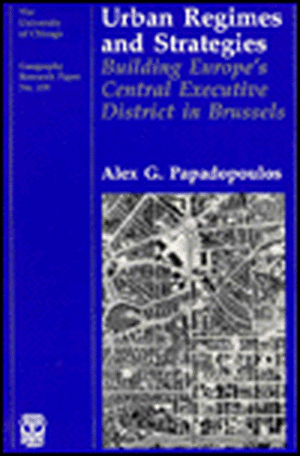Urban Regimes and Strategies: Building Europe's Central Executive District in Brussels: University of Chicago Geography Research Papers, cartea 239
Autor Alex G. Papadopoulosen Limba Engleză Paperback – 6 noi 1996
If a city based its planning decisions on the needs of an international bureaucracy rather than on the traditional needs of local residents and businesses, how would that city change? How might it look?
In Brussels, Belgium—since 1957 home to the European Union—such change is taking place. Observing the change, Alexis G. Papadopoulos explores a new geographical concept, the Central Executive District. This urban form is significantly different from the Central Business District, its conventional counterpart. Drawing on game and rational choice theories, spatial analysis, and land economics, the author analyzes how the landscape of the city's center has evolved over the last three decades under the influence of successive coalitions of local and foreign elites. He describes how foreign diplomats, international corporate executives, and real-estate developers cooperate with one another to carry out major urban projects in the face of resistance from local neighborhood groups, conservationists, and political factions.
This study makes a substantial contribution to geography and urban studies both for its implications about the future of world cities like New York, London, and Paris and for its original application of the notion of cooperative regimes.
In Brussels, Belgium—since 1957 home to the European Union—such change is taking place. Observing the change, Alexis G. Papadopoulos explores a new geographical concept, the Central Executive District. This urban form is significantly different from the Central Business District, its conventional counterpart. Drawing on game and rational choice theories, spatial analysis, and land economics, the author analyzes how the landscape of the city's center has evolved over the last three decades under the influence of successive coalitions of local and foreign elites. He describes how foreign diplomats, international corporate executives, and real-estate developers cooperate with one another to carry out major urban projects in the face of resistance from local neighborhood groups, conservationists, and political factions.
This study makes a substantial contribution to geography and urban studies both for its implications about the future of world cities like New York, London, and Paris and for its original application of the notion of cooperative regimes.
Preț: 235.40 lei
Preț vechi: 280.86 lei
-16% Nou
Puncte Express: 353
Preț estimativ în valută:
45.04€ • 47.16$ • 37.27£
45.04€ • 47.16$ • 37.27£
Carte indisponibilă temporar
Doresc să fiu notificat când acest titlu va fi disponibil:
Se trimite...
Preluare comenzi: 021 569.72.76
Specificații
ISBN-13: 9780226645599
ISBN-10: 0226645592
Pagini: 310
Ilustrații: 23 halftones, 36 line drawings
Dimensiuni: 152 x 229 x 18 mm
Greutate: 0.41 kg
Ediția:1
Editura: University of Chicago Press
Colecția University of Chicago Press
Seria University of Chicago Geography Research Papers
ISBN-10: 0226645592
Pagini: 310
Ilustrații: 23 halftones, 36 line drawings
Dimensiuni: 152 x 229 x 18 mm
Greutate: 0.41 kg
Ediția:1
Editura: University of Chicago Press
Colecția University of Chicago Press
Seria University of Chicago Geography Research Papers
Cuprins
List of Figures
List of Tables
Acknowledgments
Prologue
1. Introduction
2. Theoretical Foundations
3. The Historical Background
4. The Planning Aspect
5. The Quartier as Land Market
6. National, Ethnic, or City Interests First? The Quartier as Political Artifact
7. From the Boudoir to the Trenches: Two "Rational" Urban Games
8. In Search of Monumentality in Consumption
9. Conclusions
Appendix: Building Permit for the Centre International du Congrés
Bibliography
Index
List of Tables
Acknowledgments
Prologue
1. Introduction
2. Theoretical Foundations
3. The Historical Background
4. The Planning Aspect
5. The Quartier as Land Market
6. National, Ethnic, or City Interests First? The Quartier as Political Artifact
7. From the Boudoir to the Trenches: Two "Rational" Urban Games
8. In Search of Monumentality in Consumption
9. Conclusions
Appendix: Building Permit for the Centre International du Congrés
Bibliography
Index










